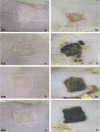The effect of Quercus brantii gall extract on burn wound healing in rat
- PMID: 27872712
- PMCID: PMC5110664
The effect of Quercus brantii gall extract on burn wound healing in rat
Abstract
Objectives: The aim of the present study was to evaluate the effect of Quercus brantii galls extract on the rat skin burn wound healing.
Materials and methods: Ethanol extract of the galls of Q. brantii was used to treat the induced burn wounds on the back of 32 Wistar rats divided into 4 groups. The groups were treated by placebo, 1%, 2% and 4% concentration gall extract gels for 14 days and the efficacy of treatment was assessed based on reduction of burn wound area, as well as histological and molecular characteristics.
Results: The mean wound surface in the 14th day, in all groups treated by Q. brantii gall extracts were larger than control group and the differences were statistically significant (P=0.043). The mean histological wound healing scores were not statistically different. Analysis of nitric oxide and platelet derived growth factor concentration in wound fluids in the 5th day of study showed that there was not any significant difference between groups (P=0.468 and 0.312 respectively). Fibroblast growth factor (bFGF) concentration in the wound fluids, was significantly higher in group treated with 1% gall extract gel in comparison to the control group (P=0.026).
Conclusion: Our results could not prove the significant positive effect of Q. brantii galls extract on the burning wound healing. More studies with more groups treated with different doses of the Q. brantii extract are recommended.
Keywords: Burn wound healing; Gall extract; Quercus Brantii.
Figures


Similar articles
-
Effect of Hydro-alcoholic Extract of Persian Oak (Quercus brantii) in Experimentally Gastric Ulcer.Iran J Pharm Res. 2014 Summer;13(3):967-74. Iran J Pharm Res. 2014. PMID: 25276198 Free PMC article.
-
On the benefit of galls of Quercus brantii Lindl. in murine colitis: the role of free gallic acid.Arch Med Sci. 2014 Dec 22;10(6):1225-34. doi: 10.5114/aoms.2014.47831. Arch Med Sci. 2014. PMID: 25624862 Free PMC article.
-
Quercus infectoria gall extract aids wound healing in a streptozocin-induced diabetic mouse model.J Wound Care. 2021 Aug 2;30(8):618-625. doi: 10.12968/jowc.2021.30.8.618. J Wound Care. 2021. PMID: 34382850
-
Safety assessment of the Quercus brantii gall hydroalcoholic extract: Single and repeated oral dose toxicity studies.Iran J Basic Med Sci. 2022 Nov;25(11):1389-1395. doi: 10.22038/IJBMS.2022.65488.14418. Iran J Basic Med Sci. 2022. PMID: 36474575 Free PMC article.
-
Pistacia atlantica Resin Has a Dose-Dependent Effect on Angiogenesis and Skin Burn Wound Healing in Rat.Evid Based Complement Alternat Med. 2013;2013:893425. doi: 10.1155/2013/893425. Epub 2013 Oct 27. Evid Based Complement Alternat Med. 2013. PMID: 24285978 Free PMC article.
References
-
- Atiyeh BS, Costagliola M, Hayek SN, Dibo SA. Effect of silver on burn wound infection control and healing: review of the literature. Burns. 2007;33:139–148. - PubMed
-
- Bastos ML, Houly RL, Conserva LM, Andrade VS, Rocha EM, Lyra Lemos RP. Antimicrobial and wound healing activities of Piper hayneanum. J Chem Pharm Res. 2011;3:213–222.
-
- Singer AJ, Clark R. Cutaneous wound healing. N Engl J Med. 1999;341:738–746. - PubMed
-
- Cohen JL, Jorizzo JL, Kircik LH. Use of a topical emulsion for wound healing. J Support Oncol. 2007;5:1–9. - PubMed
LinkOut - more resources
Full Text Sources
